- New Sailboats
- Sailboats 21-30ft
- Sailboats 31-35ft
- Sailboats 36-40ft
- Sailboats Over 40ft
- Sailboats Under 21feet
- used_sailboats
- Apps and Computer Programs
- Communications
- Fishfinders
- Handheld Electronics
- Plotters MFDS Rradar
- Wind, Speed & Depth Instruments
- Anchoring Mooring
- Running Rigging
- Sails Canvas
- Standing Rigging
- Diesel Engines
- Off Grid Energy
- Cleaning Waxing
- DIY Projects
- Repair, Tools & Materials
- Spare Parts
- Tools & Gadgets
- Cabin Comfort
- Ventilation
- Footwear Apparel
- Foul Weather Gear
- Mailport & PS Advisor
- Inside Practical Sailor Blog
- Activate My Web Access
- Reset Password
- Customer Service

- Free Newsletter


Catalina 42 Mk I and Mk II
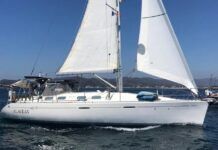
Beneteau First 42s7 Used Boat Review

Pearson 303 Used Boat Review

Grampian 26 Used Boat Review

Special Report: How to Prevent AIS and VHF Antenna Malfunction

Vesper Marine WatchMate 850 and Icom M91D: Where Credit is Due

How to Create a Bullet-Proof VHF/SSB Backup

Tips From A First “Sail” on the ICW

Haul Out Tips to Avoid Confusion and Delays

Checking Rope Strength

Lashing for Strength

Are Wrinkles Killing Your Sail Shape?

Ensuring a Safe Space for Batteries
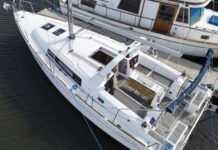
Impact of Modern, Triangular-Design on Boat Performance
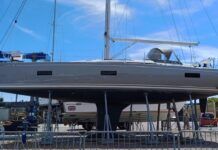
Keel and Rudder Design Basics

Diesel-Electric Hybrids Vs. Electric: Sailing’s Auxiliary Power Future
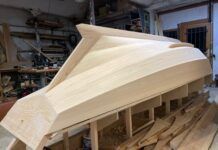
Wooden Boat Revival: Can Boatbuilding Be Regenerative?
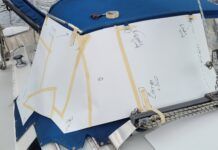
How to Make Dodger Cover Canvas Pattern

How Much Does It Cost to Keep a Boat on the…
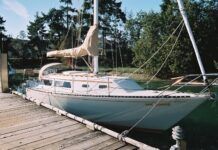
Insurance For Older Sailboats

PS Advisor: Acid Cleaning Potable Water Systems

Product Hacks: Velcro, Bounce, Anti-Skid Mats and Pool Lights

Stopping Holding-tank Odors
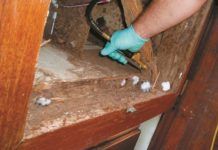

Giving Bugs the Big Goodbye

Five Best Cheap Clothing Options for Cold-Weather Sailing

How to Scuba from Your Boat

Compact Scuba Kits for Sailors

Cold Weather Clothes to Extend the Sailing Season

Bilge Pump Installation and Maintenance Tips

Full-Time Ocean Trash Cleanup in the Arctic Circle

Boats That Fly? How High Tech Rocked the America’s Cup

R. Tucker Thompson Tall Ship Youth Voyage

On Watch: This 60-Year-Old Hinckley Pilot 35 is Also a Working…
- Sailboat Reviews
A trailerable pocket cruiser introduced in 1984 by Hake Yachts, this pricy plumb-bowed sloop is made for exploring the shallows. It's laid out for a cruising couple or young family.
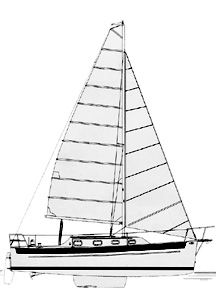
Nick Hake graduated from the Milwaukee School of Engineering in 1974, then pulled up stakes and left the cold Great Lakes winters for sunny Miami, where he became head chef at Horatio’s restaurant in the tower of the Coconut Grove Hotel. While working nights in that occupation, he began building boats for profit, starting with molds and dinghies. Of those times, he says “It’s what I wanted to do. I love boats and always wanted to be self-employed.”
Within the year, he was ready to take the plunge into full-time boatbuilding, so he hung out his shingle and set up shop. In the ensuing eight years he built 2,000 dinghies before introducing a 17-foot sloop he called the Slipper. Eventually stretched to 18 feet, the boat was renamed The Fox, to distinguish it from a competitor’s daysailer called The Hen.
Five years later Hake introduced a 22-footer, and named his company Seaward. He eventually stretched the 22 into a 23, which he still builds; then, exhibiting a case of one-foot-itis, made a 24-footer. That one he stretched to 25 feet—and that boat is the subject of our story. It’s built in the Stuart, Florida warehouse that Hake established in 1984. along with its 18, 23-, and 32-foot siblings.
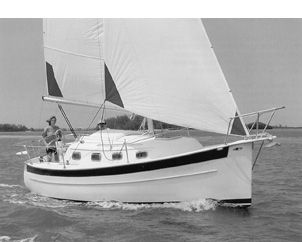
All of Hake’s boats are shallow-draft designs for trailer sailors. He’s in the process of building tooling for the prototype of a 45-footer for his personal use that will be put into production after testing in the Caribbean. It, too, is designed with a shallow draft for gunkholers.
Since its formation, the company has produced 2,000 dinghies, 1,000 Foxes, 300 23-footers, 591 25-footers, and 41 of its relatively new 32- footer.
In 1993 Hake was approached by a group of Philadelphia lawyers who owned a conglomeration of other businesses, and he sold them the company. However, after two years, the economics of the boatbuilding business wore thin with the investors. When they offered to sell the company back to Hake for pennies on the dollar, he again assumed ownership. “I learned how much I missed the business,” he says. “Now I have the luxury of managing it as a non-starver, compared to some other builders.”
Design Of his designs Hake says, “I have no interest in racing, but I do want to go fast. I want to design and build boats that will go as fast as possible, within the context of boats that are gunkholers.”
He categorizes the Seaward 25 as a “pocket cruiser for adult audiences. I designed a boat that is the target boat I would build for myself for cruising in Florida’s waters and in the open sea down to the islands. I built it for the stuff I do.”
The hull is designed with a nearly plumb bow and stern to maximize waterline, and performance. The company’s brochures are misleading here: The LWL is published as 23′, but is 23’8″; the LOA is 26’9″. However, the length on deck at the headstay is nearly identical to the LWL, the difference accounted for by the anchor platform.
Hake describes the hull shape as having a “spherical tumblehome,” with soft chines and bilges, as compared to flatter sections on other boats. Considering her displacement of 3,600 pounds, of which 1,200 pounds is ballast, and 280 square feet of sail, the design produces a tender performer.
He says she performs best when heeled 10 degrees, and that sail should be shortened when the wind pipes up to 15-17 knots. Sailing a test boat in 8 knots of breeze with a full main and 135% genoa, we were within Hake’s recommended heel angle and the helm was balanced.
Of the relatively high topsides and bow, he says “they’re designed that way because I don’t want water coming over the bow. I don’t like to be wet.”
Underwater appendages are a shallow, 2′ 1″ deep, 8-foot long fixed keel, and a fairly small, low-aspect transom-hung rudder. In a modification from early models, Hake added a 26″ wing to the aft part of the keel in 1989. The wing helps increase the keel’s profile when heeled, and, according to Hake, improves upwind perfomance.
The Seaward 25 has been on the market since 1984 in various models, and is continually evaluated with an eye to improving performance or livability. It was last redesigned in 1995.
Appearance Curbside, this boat’s appearance and hints of her personality seem to change with one’s point of view. Viewed from the forward quarter, her most striking characteristics are a plumb bow, a high, sloping sheer line, and beam carried well aft, with a bit of tumblehome near the cockpit.
In profile, she looks workmanlike. A moderate sailplan on a single- spreader 7/8 rig balances a cabintop extending far enough forward of the mast to carry headroom into the forward cabin without appearing top-heavy.
Her profile is accented by the anchor platform, four shiny stainless steel ports, and bow and stern pulpits. Call her gracefully workmanlike, or purposefully fair, depending on your point of view.
Deck Layout Since she was conceived by Hake as a “sailboat for mature audiences,” the rig, layout of deck gear, and cockpit size are straightforward and uncomplicated. Though wheel steering is an option, and space is available for installation of cockpit speakers, she’s a far cry from a dockside entertainment center. The wheel diameter is 24″, which allows easy movement for helmsman and access to the stern gate. However, after our test sail we concluded that we’d prefer steering with either a tiller or a larger wheel, so steering from the rail doesn’t wear out the triceps.
With 46″ of clearance between the wheel pedestal and companionway, and 25″ wide cockpit sole, she’ll seat four on seats and two in aft corners. Seats are 15″ wide and backrests 11″ high, adequate for most adults. Moving around in the cockpit while underway will be a greater challenge if she’s equipped with a tiller.
With the mainsheet located mid-boom, the trimmer operates at the companionway. Primary winches are close at hand, so the helmsman can steer without interfering with crew; conversely, the controls are close enough to allow relatively easy singlehanded sailing.
Halyards are led aft through stainless turning blocks to Ronstan rope clutches and an Anderson #10 winch. Replacement of primary winches with Anderson #16 self-tailers is a $650 option.
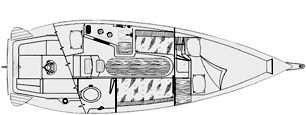
The starboard lazarette is 28″ deep, 34″ inches wide, and more than 6 feet long—adequate for storage of an inflatable dinghy or spare sails. Space for a 6-gallon fuel tank is located under the aft starboard seat. Whether equipped with a one-lung diesel or outboard, this is a good idea that other builders of boats this size would do well to emulate. The tank is easily accessible, portable, saves space belowdecks, and reduces production costs.
There’s no locker to port since the space below is occupied by a quarterberth. The seat lid raises to provide access or ventiliation to the berth.
A recent change from wood to Delrin runners for companionway hatchboards means the hatch has decreased friction, maintenance needs, and cost, and greater weather resistance.
The deck is surrounded by 22″ pulpits and a 20″ tall lifeline. Movement underway was unimpeded, except by a dodger that narrowed the space between the cockpit and toerail. Shrouds dead-ended at the top of the cabintop and stainless steel handrails on the cabintop all provide excellent handholds. The nonskid has a very aggressive pattern that provides grip on a wet deck and adds to her appearance.
At the bow, a stainless steel strike rail forward of the hawsepipe protects the deck from being damaged by ground tackle. The anchor well, a compartment isolated from the forward cabin, holds 20-30 feet of chain and 150 feet of line. It drains overboard. A single 10″ stainless cleat, larger than those found on most similar-sized boats, is on the foredeck. A Bowmar bow hatch is 17″ square.
As on many boats with deck-stepped masts, electrical connections may create problems. The wiring connections at the butt of the mast can be damaged or kicked loose, but maybe that goes with the territory.
The backstay is attached to the stern pulpit, and this concerned us: It was hard to see how to get good headstay tension, and with mid-boom sheeting we thought there might even be mast stability worries. Hake says the mast is so stiff that bending it is not worth trying. As for strength, he provided photos of a boat suspended from a crane with lines attached to bow and stern pulpits.
Belowdecks Hake espouses two principles that affect his approach to designing spaces belowdecks. The first places function ahead of form: “We use every inch of space we can, and design so everything can be removed and the interior hosed out for cleaning.” That’s a worthy objective, certainly more easily accomplished on a 25-footer than a larger cruiser. Solid doors, however, are installed for privacy in the forward stateroom and head.
Second: “We use no carpeting, cloth, or Formica, because they tend to absorb moisture and odors, peel, chip and tear, and are hard to clean.” The company will, however, install wood battens on the hull in the cabin for owners wishing for a warmer feel.
Arrangement of spaces belowdecks is straightforward. The galley runs fore and aft to port, opposite the head; a short settee to port sits opposite a 6- footer to starboard that converts to a berth. Other sleeping accommodations are in the bow and a quarterberth in the port quarter.
The dining table is mounted on the bulkhead and secured with an eye and hook, but has no legs. It is deployed by being unlatched to a horizontal position and moved horizontally on a stainless steel bar until situated amidships. At that point, two adults on both sides of the table can dine. It’s a good arrangement, except that when not in use, the wire securing the table to the bulkhead forms a loop that could catch an unsuspecting passenger. Add Velcro and the problem is solved.
Headroom in the cabin is 5′ 6″, but slightly higher in the galley when the hatch is open.
Operating space on the galley counter is 19″ x 15″ inches, and the space in which the stove is mounted 25″ x 42″—adequate for the preparation of typical sailing meals. The galley may be equipped with a one- or two-burner Origo alcohol stove. The ice box is big enough to hold two large ice blocks.
While there are bunks for four, real privacy will be hard to find, as on any boat this size. It’s best for a couple, or a couple with one or two small fry.
The forward cabin has a 7′ V-berth that is 57″ wide at the head. Clearance between the top of the cushion and the deck is 39″, so there’s room to dress while seated on the cushion without banging the deck. A vanity to starboard is 30″ x 16″; storage is in a hanging locker to port and shelves lining the hull. Fresh air comes from three vents.
Like most quarterberths, this one is designed to double as a storage area. The berth is 80″ long and 32″ wide, outfitted with a thin pad. When not in use, the pad can be rolled up and stored in straps attached to the hull. However, a crewmember intending to sleep frequently in the space will benefit from a thicker pad.
Interestingly, the designer’s intent is for two crew to sleep athwartships when the port and starboard settees are united across the center of the saloon to create a double berth.
The head is a small, enclosed space with a sit-down shower, Jabsco toilet, and one opening port. There’s no sink, and pressurized hot water is an option.
If installed, a diesel is located below the companionway steps, with 270-degree accessibility from the cabin. Access aft is from the starboard cockpit cocker, or by removing a panel in the quarterberth.
Common complaints about the boat are the lack of engine and ice box insulation.
“Those are legitimate,” Hake says. “We had to sacrifice somewhere, so the thickness of insulation in the ice box is between 1-3/4″ and 2-1/2″. But it’s been improved in the last year. We can always add insulation to the engine box, but that adds a lot of weight.”
Construction Hake estimates that 500 man-hours are spent in the construction of each Seaward 25. Based on our inspection of four boats, three used, it appears that his crew is doing good work.
The lamination schedule for all Seaward models is substantially the same: following the application of a gelcoat, vinylester resins are employed in the skin coat. The next step is the layup of 1.5-ounce chop-strand mat applied with a chopper gun. “I know some people don’t like that,” says Hake, “but it’s an effective way of assuring that there’s resin on both sides of the strands.”

The balance of the layup includes a layer of 2 mm Coremat, which helps prevent print-through from the main laminate, followed by 1.5-oz.mat, 34-oz. triaxial cloth to add density and strength, and 1708 biaxial or 34-oz. triaxial mat. There’s no wood or structural coring in the layup of a hull.
In the deck, PVC foam and Coremat are provide structure and sound deadening, and the headliner is a solid fiberglass structural member vacuum-bonded to the deck.
Deck hardware is tapped into 1/8″ aluminum plates bedded in the fiberglass lamination, which has been tested to 14,000 psi, Hake says. “The aluminum has been tested to withstand 20,000 psi.”
The hull-deck joint is bonded with a slurry of polyester putty impregnated with talc and fibers, and fastened with stainless steel bolts on 6″ centers. The keel is constructed of a hollow fiberglass structural mold into which a slurry of resin and lead are added. It is attached to the hull with 5/8″ threaded rods embedded into the ballast and bolted, glued, and glassed to the hull.
The company fabricates most of its stainless steel parts, including shiny, precisely fabricated stainless steel ports, and four-bolt cleats.
With such a long production run, there are some differences in construction details and quality between model years. Prospective buyers should consult online discussion groups for specifics, for example the Seaward Yachts Forum linked through www.trailersailor.com .
Performance With assistance from Karen Trusty of The Sailing Life in Portland, Oregon, we sailed a two-year-old Seaward 25 on the Columbia River. At 6′ tall and weighing 165 pounds, the owner of the boat claims that he can rig and launch the boat by himself in only 1-1/2 hours.
Once underway we learned that she turns in a boatlength, despite the length of her keel, and backs in a straight line once the helmsman compensates for prop walk.
We sailed in 8-10 knots of wind, flying a 135-percent genoa, the maximum recommended by the designer, and full mainsail. The helm was responsive, and the boat quickly accelerated with the occasional puff of breeze.
In a steady breeze we sailed at 4-5 knots on a reach. Hardening up and pushing to within 45 degrees of the wind, speed dropped by about a knot. We couldn’t record precise speeds because of a dirty speedo impeller. In fact, it was hard to get an accurate feel for her performance altogether, because the river current flows into the prevailing winds. However, sailing cross-current on a beam reach, she showed good speed, helm balance, and tracking. We’d like to take a longer sail to weather in open water.
She did provide a comfortable ride, especially when compared to water- ballasted trailerables, and was easy to sail with little muscular effort.
Power Optional powerplants are an outboard or 9- or 20-horsepower Yanmar diesels. Most boats are equipped with the1GM10, but owners in areas with stronger current and bigger seas voice the opinion that the larger engine is a better choice.
Price Characterized by Hake as a “Volvo,” there’s no arguing that the boat is priced in the upper stratosphere, compared to similar-sized trailerables.
Base price for the Seaward 25 is $34,000, FOB the factory. Add a wheel ($1,900), mast crutch ($210), 25 gallon portable head ($375), one-burner Origo stove ($250), Yanmar 1GM10 ($7,100), galvanized double-axle trailer ($3,600), instruments, and other accessories, and the price escalates by 25-40 percent.
Of the price, Hake says, “First, stand back and look at the boat. It’s very nice to have people stop you wherever you go and say ‘nice-looking boat.’ We pay more for one of our ports than the production builders pay for all of theirs, and ours are worth it. Same for our 4-bolt cleats, stanchion bases, winches, blocks. Our glasswork is several steps better. We recently made our trailer people use 2″ bearings, 6-ply steel-belted tires, and the best brakes you can put on a trailer.”
Conclusion We examined four of the boats, one new and three used. We found the workmanship to be consistent. Gelcoat surfaces were smooth and free of printthrough. We saw no evidence of crazing. Except for normal wear and tear, a well-maintained boat appears to stand up well to normal use. Construction is certainly solid, and the hardware first-rate. We still aren’t sure about the backstay connection, but do acknowledge the picture of the boat being suspended by the pulpits.
The basic hull design and rig are well-suitedfor coastal sailing, real gunkholing, and fairly easy trailering. The cockpit, deck, and running rigging layouts are simple and workable for a singlehander. The layout belowdecks shows a sensible mix and weighting of elements—an enclosed toilet and a workable galley in a boat this size are pretty fair accomplishments. The “camper” elements—portable fuel tank provision, ability to access the quarterberth from the cockpit, large ice-box space with the sacrifice of insulation—seem to us wise choices, considering how the boat will likely be used.
For most potential buyers, her greatest drawback will be price. Water-ballasted, trailerable 25-footers (her competition) sell for significantly less, assuming the use of outboard power. They aren’t built as robustly, and will depreciate faster and farther, but they get the basic job done. The extra $300-400 per foot that Hake charges for the Seaward 25 might, for the devoted cruising couple in Florida, the Bahamas, or anywhere there’s shallow water to be explored, be worth the difference in the long run.
In the used-boat market, the resale value of a five-year-old Seaward 25 is typically between 85 and 90 percent of its original price. At press time, there are 12 used Seaward 25s advertised for sale on the Internet. Asking prices range from $13,500 to $53,900, with the average around $42,000.
Hake Yachts, Inc. 772/287-3200 www.seawardyachts.com
RELATED ARTICLES MORE FROM AUTHOR
Hello owner of 1995 seaward 25 26,9 with 9 hp can I install a 3 cyl fresh water Yanmar with out much difficulty
also added 2 in forward and 2 in depth on rudder, was thinking of adding 4 in to the wing keel Thank You
I have a 25′ from 1990, Great boat ! considering replacing the rigging soon. Does anyone know if the end fittings on mast are Seaward/Hake specific?!
LEAVE A REPLY Cancel reply
Log in to leave a comment
Latest Videos

24 Knot Speed Trimaran – The Dragonfly 40 Ultimate

AMAZING Sailboat Drones, US Navy Deploys 65 Foot Sailing Drone

The SHOCKINGLY Comfortable Million Dollar Sailboat From Moody

New Sailor CRASHES and Needs Advice!
Latest sailboat review.
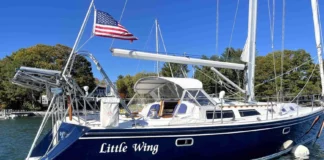
- Privacy Policy
- Do Not Sell My Personal Information
- Online Account Activation
- Privacy Manager
Great choice! Your favorites are temporarily saved for this session. Sign in to save them permanently, access them on any device, and receive relevant alerts.
- Sailboat Guide
Hake Yachts (Seaward)
Hake Yachts, Inc. was founded by Nick Hake. Hake purchased Island Packet and Blue Jacket in April 2016. Hake was subsequently purchased by Darrell and Leslie Allen in January 2017. All manufacturing for Seaward Yachts is now done at the Island Packet manufacturing facility in Largo Florida. 1979 Wild Acres Road Largo, Florida 33771 Original location: 4550 SE HAMPTON COURT STUART FL 34997 USA Parts Information - 727.535.6431
12 sailboats built by Hake Yachts (Seaward)

Seaward Eagle

Seaward Fox
Seaward 32rk.

Seaward 46RK
Seaward 26rk.

- About Sailboat Guide
©2024 Sea Time Tech, LLC
This site is protected by reCAPTCHA and the Google Privacy Policy and Terms of Service apply.
| Hake Yachts Seaward 23
| |||||||||||||||||||||||||||||||||||||||||||||
IMAGES
COMMENTS
Hake Yachts, Inc. was founded by Nick Hake. Hake purchased Island Packet and Blue Jacket in April 2016. Hake was subsequently purchased by Darrell and Leslie Allen in January 2017. All manufacturing for Seaward Yachts is now done at the Island Packet manufacturing facility in Largo Florida. 1979 Wild Acres Road Largo, Florida 33771 Original location: 4550 SE HAMPTON COURT STUART FL 34997 USA ...
Hake Yachts, also called Seaward Yachts, was an American boat builder based in Carmel, Indiana. The company specialized in the design and manufacture of fiberglass sailboats. [1] [2] [3] The company was founded in 1973 by boat designer Nick Hake, a graduate of the Milwaukee School of Engineering. [1] [2] [4]
27' Hake Yachts Seaward 26RK Conch Key, Florida Asking $45,000. 22' Ranger 22 Eagle Creek Sailing Club Indianapolis, Indiana Asking $4,500. 31.67' Pearson 31-2
Jan 7, 2003 · In the used-boat market, the resale value of a five-year-old Seaward 25 is typically between 85 and 90 percent of its original price. At press time, there are 12 used Seaward 25s advertised for sale on the Internet. Asking prices range from $13,500 to $53,900, with the average around $42,000. Hake Yachts, Inc. 772/287-3200 www.seawardyachts.com
Hake Yachts, Inc. was founded by Nick Hake. Hake purchased Island Packet and Blue Jacket in April 2016. Hake was subsequently purchased by Darrell and Leslie Allen in January 2017. All manufacturing for Seaward Yachts is now done at the Island Packet manufacturing facility in Largo Florida. 1979 ...
27' Hake Yachts Seaward 26RK Conch Key, Florida Asking $45,000. 38.7' Sabre 38 Mk II Solomons, Maryland Asking $99,850. 45' Downeaster Cutter 45 Marina del Rey ...
How much do Seaward boats cost? Seaward boats for sale on YachtWorld are listed for a swath of prices from $34,900 on the relatively lower-priced models, with costs up to $989,719 for the most luxurious yachts. What Seaward model is the best? Some of the best-known Seaward models presently listed include: 25, 26RK, 35, 29 and 42.
Hake / Seaward boats on Boat Trader. Hake / Seaward is a boat builder in the marine industry that offers boats for sale in a variety of sizes on Boat Trader, with the smallest current boat listed at 26 feet in length, to the longest vessel measuring in at 48 feet, and an average length of 33.59 feet.
Jul 3, 2020 · 92 24' Hake Yachts Seaward 23 sailboat for sale in Diamond Point Lake George New York. ... This Hake Yachts Seaward 23 : Added 03-Jul-2020 Hake Yachts Sailboats
Find Hake / Seaward boats for sale in your area & across the world on YachtWorld. Offering the best selection of Hake / Seaward boats to choose from.